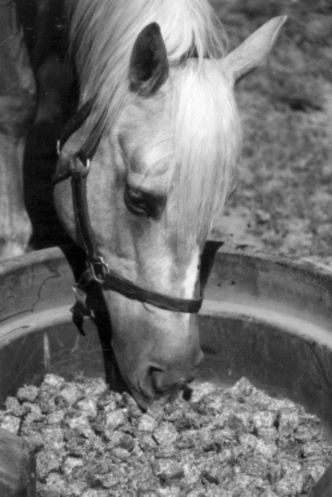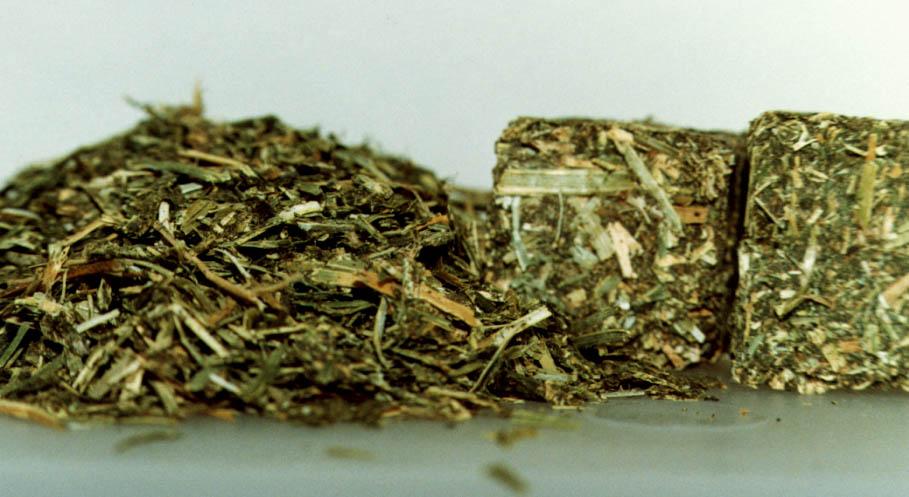Alfalfa Cubes for Horses
Alfalfa Cubes for Horses
Authors: Robert J. Coleman and Laurie M. Lawrence, Department of Animal Sciences; Jimmy C. Henning, Department of Agronomy

Forage is the basis for feeding programs for all classes of horses. Forage contains many nutrients, and the fiber provided by forage is essential for the maintenance of the horse's gastrointestinal health. Hay and pasture are the typical forage sources for horses, but when growing or harvesting conditions limit their availability, horse owners have to consider alternative forage sources.
Forage cubes are gaining popularity as an alternative to feeding long-stem hay. The cubes available may be 100% alfalfa, a mixture of alfalfa and grass, or a more recent product which is a mixture of alfalfa and whole corn plant. Availability of the different products will vary with local suppliers. For most horse owners, 100% alfalfa cubes is the product most readily available. As with any feedstuff, there are advantages and disadvantages that must be considered when making your decision to use alfalfa cubes in feeding programs for your horses.

Advantages of Alfalfa Cubes
- Reduced feed waste. Cubes are not wasted to the same extent as long-stem hay even if fed on the ground. Horses fed long- stem hay can separate the leaves from the stems and consume the parts they prefer; this does not happen with cubes.
- Controlled feed intake. It is easier for the horse owner to monitor and regulate the daily intake of cubed forage than long-stem hay.
- Consistent nutrient content. The nutrient levels found in cubes tend to be more consistent than hay. Alfalfa cubes are sold with a guaranteed minimum nutrient content.
- Reduced dust. Cubes have little dust and are therefore a good alternative to hay for horses with certain respiratory problems.
- Ease of handling. Cubes can be mechanically handled in bulk.
- Reduced storage requirements. Cubes are more dense than hay and therefore require less storage space.
- Reduced transportation costs. Cubes are more dense than hay and allow trucks to be loaded to their full legal capacity. This is not always possible with hay. Shipping costs for cubes can be reduced, assuming the shipping distance is the same.
- Ease of transport. Alfalfa cubes take up less space in the trailer and may be easier for horse owners to take to shows or on trail rides.
Disadvantages of Alfalfa Cubes
- Excessive feed intakes. Cubes must be fed in a controlled manner to avoid overweight horses and, more importantly, to avoid serious digestive upsets.
- Handling. Alfalfa cubes require a storage area that provides protection from the weather to prevent spoilage caused by excessive moisture.
- Cost. Processing adds to the cost of the feed, and there may be additional costs associated with shipping, depending on the distance from point of production to point of sale. The major sources for cubed alfalfa are the western United States, western Canada, and Ontario.
What Are Alfalfa Cubes and How Are They Made?
In general, there are two types of cubesdehydrated and suncured. Dehydrated cubes are made
from alfalfa that is cut at an early stage of maturity and is partially dried in the field. The wilted alfalfa is picked up and chopped using a forage harvester. This material is transported to the processing plant where it is dehydrated to 95% dry matter and cubed. The sun-cured cubes are
produced by allowing the alfalfa to dry in the field. The cured forage is then baled and transported to the processing plant, where it is chopped and cubed. The result of either processing method is alfalfa forage in a small package.
Alfalfa cubes are similar to long-stem hay in digestible energy, crude protein, and calcium content (Table 1). The use of alfalfa cubes eliminates the sorting of leaves from stems, so the cubed product provides a more uniform feed. Cube buyers always have nutrient information provided, as this product is sold with a nutrient guarantee. In most situations when long-stem hay is purchased, the horse owner may need to test the hay to determine the nutrient content.
| Table 1. Nutrient comparison between alfalfa hay and alfalfa cubes. a | |||||
| Feed Type | Dry Matter % | Digestible Energy mcal/kg |
Crude Protein % | Calcium % | Phosphorus % |
| Alfalfa Hayb | 90 | 2.48 | 19.9 | 1.28 | 0.21 |
| Alfalfa Cubesc | 89 | 2.45 | 19.0 | 1.44 | 0.22 |
| aAll values are on a dry matter basis. bValues for the alfalfa hay are taken from the 1989 Nutrient Requirements for Horses. cValues for the alfalfa cubes are based on industry values from cube manufacturers. |
Research with alfalfa cubes has shown that cubes are effective as the forage component in horse diets. However, alfalfa cubes must be limit-fed, as voluntary intake is much greater for
the cubes than for long-stem alfalfa hay. Horses fed to appetite consumed 17 to 25% more cubed alfalfa than long-stem hay.
Horses that are fed alfalfa cubes tend to eat all the cubes provided, whereas horses fed long-stem alfalfa hay will sort through the hay and not eat all the hay offered. Research in Colorado reported that mature horses fed alfalfa cubes maintained their body weight better than horses fed equal amounts of long-stem hay. The conclusion reached was that the horses fed the cubed alfalfa ate all the feed provided, while the horses fed the long-stem hay wasted a portion of the feed provided. Therefore, horse owners should provide alfalfa cubes in a controlled manner to prevent overconsumption of the feed, which can lead to serious digestive problems such as colic or problems associated with overweight horses.
Alfalfa cubes can be used in feeding programs to replace a portion or all of the forage that horse owners would feed their horses. Feeding suggestions using alfalfa cubes are found in Table 2.
| Table 2. Feeding suggestions for different classes of horses using alfalfa cubes.1 | |
| Mature Horses at Maintenance 500 kg or 1100 lb body weight |
|
| Alfalfa Cubes Trace Mineral Salt |
17 -18 lb per horse per day Free Choice |
| Broodmare in the 10th Month of Gestation 500 kg or 1100 lb body weight |
|
| Alfalfa Cubes Concentrate Mix4 |
15 lb per horse per day 4 lb per horse per day |
| Mature Horse at Light Work 3 500 kg or 1100 lb body weight |
|
| Alfalfa Cubes Concentrate Mix4 |
15 - 16 lb per horse per day 4.5 lb per horse per day |
| 6-Month-Old Weanling Expected mature size 500 kg or 1100 lb. Current body weight 550 lb and growing at a rate of 1.25 lb per day |
|
| Alfalfa Cubes Foal Concentrate Mix5 |
8 - 9 lb per horse per day 5 lb per horse per day |
|
1The feeding suggestions provided are to be used as guidelines for feeding alfalfa cubes. Horse owners should monitor the body condition of their horses and adjust the rations accordingly. |
The incidence of wood chewing has been reported to increase with horses fed processed feeds. Researchers investigated the incidence of wood chewing in mature horses fed either
long-stem alfalfa hay or alfalfa cubes. The horses were fed forage at 2.5% of their body weight. There was no effect of diet on the incidence of wood chewing. It appears that other factors
such as boredom or weather may be responsible for horses developing the habit of chewing wood.
Summary
Alfalfa cubes can be used effectively as the sole source of roughage for all classes of horses. Because of the high nutrient values for energy, protein, calcium, and vitamins, alfalfa cubes are very effective in feeding programs for broodmares and young growing horses. In addition, alfalfa cubes may be used for horses with certain respiratory problems as horse owners try to reduce the horses' exposure to dust and mold. With all horses, and especially the mature horse at maintenance, controlling the daily intake of alfalfa cubes is a must to prevent overfeeding.
